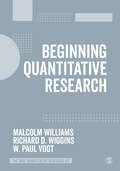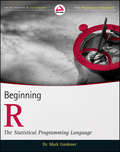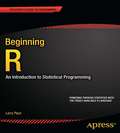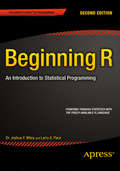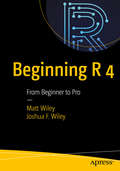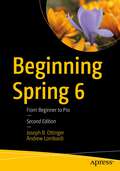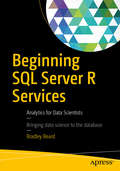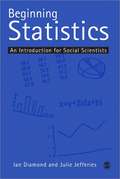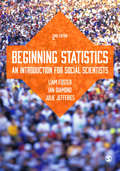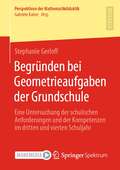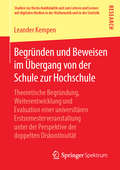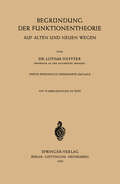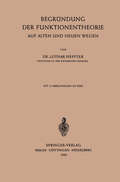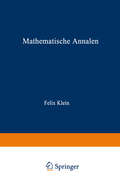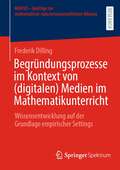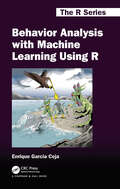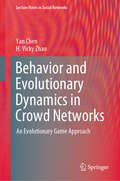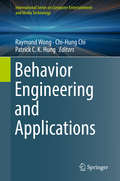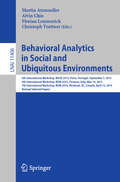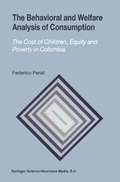- Table View
- List View
Beginning Quantitative Research (The SAGE Quantitative Research Kit)
by Malcolm Williams Richard D. Wiggins W.P. VogtThis concise text provides a clear and digestible introduction to completing quantitative research. Taking you step-by-step through the process of completing your quantitative research project, it offers guidance on: · Formulating your research question · Completing literature reviews and meta-analysis · Formulating a research design and specifying your target population and data source · Choosing an appropriate method and analysing your findings Part of The SAGE Quantitative Research Kit, this book will give you the know-how and confidence needed to succeed on your quantitative research journey.
Beginning Quantitative Research (The SAGE Quantitative Research Kit)
by Malcolm Williams Richard D. Wiggins W.P. VogtThis concise text provides a clear and digestible introduction to completing quantitative research. Taking you step-by-step through the process of completing your quantitative research project, it offers guidance on: · Formulating your research question · Completing literature reviews and meta-analysis · Formulating a research design and specifying your target population and data source · Choosing an appropriate method and analysing your findings Part of The SAGE Quantitative Research Kit, this book will give you the know-how and confidence needed to succeed on your quantitative research journey.
Beginning Quantitative Research (The SAGE Quantitative Research Kit)
by Malcolm Williams Richard D. Wiggins W.P. VogtThis concise text provides a clear and digestible introduction to completing quantitative research. Taking you step-by-step through the process of completing your quantitative research project, it offers guidance on: · Formulating your research question · Completing literature reviews and meta-analysis · Formulating a research design and specifying your target population and data source · Choosing an appropriate method and analysing your findings Part of The SAGE Quantitative Research Kit, this book will give you the know-how and confidence needed to succeed on your quantitative research journey.
Beginning R: The Statistical Programming Language
by Mark GardenerConquer the complexities of this open source statistical language R is fast becoming the de facto standard for statistical computing and analysis in science, business, engineering, and related fields. This book examines this complex language using simple statistical examples, showing how R operates in a user-friendly context. Both students and workers in fields that require extensive statistical analysis will find this book helpful as they learn to use R for simple summary statistics, hypothesis testing, creating graphs, regression, and much more. It covers formula notation, complex statistics, manipulating data and extracting components, and rudimentary programming. R, the open source statistical language increasingly used to handle statistics and produces publication-quality graphs, is notoriously complex This book makes R easier to understand through the use of simple statistical examples, teaching the necessary elements in the context in which R is actually used Covers getting started with R and using it for simple summary statistics, hypothesis testing, and graphs Shows how to use R for formula notation, complex statistics, manipulating data, extracting components, and regression Provides beginning programming instruction for those who want to write their own scripts Beginning R offers anyone who needs to perform statistical analysis the information necessary to use R with confidence.
Beginning R: The Statistical Programming Language
by Mark GardenerConquer the complexities of this open source statistical language R is fast becoming the de facto standard for statistical computing and analysis in science, business, engineering, and related fields. This book examines this complex language using simple statistical examples, showing how R operates in a user-friendly context. Both students and workers in fields that require extensive statistical analysis will find this book helpful as they learn to use R for simple summary statistics, hypothesis testing, creating graphs, regression, and much more. It covers formula notation, complex statistics, manipulating data and extracting components, and rudimentary programming. R, the open source statistical language increasingly used to handle statistics and produces publication-quality graphs, is notoriously complex This book makes R easier to understand through the use of simple statistical examples, teaching the necessary elements in the context in which R is actually used Covers getting started with R and using it for simple summary statistics, hypothesis testing, and graphs Shows how to use R for formula notation, complex statistics, manipulating data, extracting components, and regression Provides beginning programming instruction for those who want to write their own scripts Beginning R offers anyone who needs to perform statistical analysis the information necessary to use R with confidence.
Beginning R: An Introduction to Statistical Programming
by Larry PaceBeginning R: An Introduction to Statistical Programming is a hands-on book showing how to use the R language, write and save R scripts, build and import data files, and write your own custom statistical functions. R is a powerful open-source implementation of the statistical language S, which was developed by AT&T. R has eclipsed S and the commercially-available S-Plus language, and has become the de facto standard for doing, teaching, and learning computational statistics. R is both an object-oriented language and a functional language that is easy to learn, easy to use, and completely free. A large community of dedicated R users and programmers provides an excellent source of R code, functions, and data sets. R is also becoming adopted into commercial tools such as Oracle Database. Your investment in learning R is sure to pay off in the long term as R continues to grow into the go to language for statistical exploration and research. Covers the freely-available R language for statistics Shows the use of R in specific uses case such as simulations, discrete probability solutions, one-way ANOVA analysis, and more Takes a hands-on and example-based approach incorporating best practices with clear explanations of the statistics being done
Beginning R: An Introduction to Statistical Programming
by Larry Pace Joshua WileyBeginning R, Second Edition is a hands-on book showing how to use the R language, write and save R scripts, read in data files, and write custom statistical functions as well as use built in functions. This book shows the use of R in specific cases such as one-way ANOVA analysis, linear and logistic regression, data visualization, parallel processing, bootstrapping, and more. It takes a hands-on, example-based approach incorporating best practices with clear explanations of the statistics being done. It has been completely re-written since the first edition to make use of the latest packages and features in R version 3. R is a powerful open-source language and programming environment for statistics and has become the de facto standard for doing, teaching, and learning computational statistics. R is both an object-oriented language and a functional language that is easy to learn, easy to use, and completely free. A large community of dedicated R users and programmers provides an excellent source of R code, functions, and data sets, with a constantly evolving ecosystem of packages providing new functionality for data analysis. R has also become popular in commercial use at companies such as Microsoft, Google, and Oracle. Your investment in learning R is sure to pay off in the long term as R continues to grow into the go to language for data analysis and research.What You Will Learn:How to acquire and install RHot to import and export data and scriptsHow to analyze data and generate graphicsHow to program in R to write custom functionsHot to use R for interactive statistical explorationsHow to conduct bootstrapping and other advanced techniques
Beginning R 4: From Beginner to Pro
by Joshua F. Wiley Matt WileyLearn how to use R 4, write and save R scripts, read in and write out data files, use built-in functions, and understand common statistical methods. This in-depth tutorial includes key R 4 features including a new color palette for charts, an enhanced reference counting system (useful for big data), and new data import settings for text (as well as the statistical methods to model text-based, categorical data). Each chapter starts with a list of learning outcomes and concludes with a summary of any R functions introduced in that chapter, along with exercises to test your new knowledge. The text opens with a hands-on installation of R and CRAN packages for both Windows and macOS. The bulk of the book is an introduction to statistical methods (non-proof-based, applied statistics) that relies heavily on R (and R visualizations) to understand, motivate, and conduct statistical tests and modeling.Beginning R 4 shows the use of R in specific cases such as ANOVA analysis, multiple and moderated regression, data visualization, hypothesis testing, and more. It takes a hands-on, example-based approach incorporating best practices with clear explanations of the statistics being done.You will:Acquire and install R and RStudioImport and export data from multiple file formatsAnalyze data and generate graphics (including confidence intervals)Interactively conduct hypothesis testingCode multiple and moderated regression solutions Who This Book Is For Programmers and data analysts who are new to R. Some prior experience in programming is recommended.
Beginning SQL Server R Services: Analytics for Data Scientists
by Bradley BeardLearn how to develop powerful data analytics applications quickly for SQL Server database administrators and developers. Organizations will be able to sift data and derive the business intelligence needed to drive business decisions and profit. The addition of R to SQL Server 2016 places a powerful analytical processor into an environment most developers are already comfortable with – Visual Studio. This book walks even the newest of users through the creation process of a powerful R-language tool set for use in analyzing and reporting on your data.As a SQL Server database administrator or developer, it is sometimes difficult to stay on the bleeding edge of technology. Microsoft’s addition of R to SQL Server 2016 is sure to be a game-changer, and the language will certainly become an integral part of future releases. R is in fact widely used today in statistical and related applications, and its use is only growing. Beginning SQL Server R Services helps you jump on board this important trend by providing good examples with detailed explanations of the WHY and not just the HOW.Walks you through setup and installation of SQL Server R Services.Explains the basics of working with R Tools for Visual Studio.Provides a road map to successfully creating custom R code.What You Will LearnDiscover R’s role in the SQL Server 2016 hierarchy.Manage the components needed to run SQL Server R Services code.Run R-language analytics and queries inside the database.Create analytic solutions that run across multiple datasets.Gain in-depth knowledge of the R language itself.Implement custom SQL Server R Services solutions.Who This Book Is ForAny level of database administrator or developer, but specifically it's for those developers with the need to develop powerful data analytics applications quickly. Seasoned R developers will appreciate the book for its robust learning pattern, using visual aids in combination with properties explanations and scenarios. Beginning SQL Server R Services is the perfect “new hire” gift for new database developers in any organization.
Beginning Statistics: An Introduction for Social Scientists (1st edition)
by Ian Diamond Julie JefferiesWith an emphasis on description, examples, graphs and displays rather than statistical formulae, this book is the ideal introductory guide for students across the social sciences. It shows how all students can understand the basic ideas of statistics at a level appropriate with being a good social scientist. The authors explain the right ways to present data, how to describe a set of data using summary statistics and how to infer what is going on in a population when all you have to go on is the sample. The book uses small data sets to help students understand the basic principles, and no mathematics or statistical background is assumed.
Beginning Statistics: An Introduction for Social Scientists
by Liam Foster Ian Diamond Julie BantonIn the Second Edition of this bestselling textbook, the authors use real-world examples to introduce basic principles in statistics with no prior knowledge or experience assumed. With an emphasis on describing concepts, showing through example and illustrating points with graphs and displays, this book will provide readers with a step-by-step introduction to using statistics. Chapters address the following questions: Why bother learning statistics in the first place and are they relevant to real life? How do I make sensible tables and informative graphs? What are descriptive and inferential statistics and how are they used? What are regression and correlation anyway?
Beginning Statistics: An Introduction for Social Scientists
by Liam Foster Ian Diamond Julie BantonIn the Second Edition of this bestselling textbook, the authors use real-world examples to introduce basic principles in statistics with no prior knowledge or experience assumed. With an emphasis on describing concepts, showing through example and illustrating points with graphs and displays, this book will provide readers with a step-by-step introduction to using statistics. Chapters address the following questions: Why bother learning statistics in the first place and are they relevant to real life? How do I make sensible tables and informative graphs? What are descriptive and inferential statistics and how are they used? What are regression and correlation anyway?
Begründen bei Geometrieaufgaben der Grundschule: Eine Untersuchung der schulischen Anforderungen und der Kompetenzen im dritten und vierten Schuljahr (Perspektiven der Mathematikdidaktik)
by Stephanie GerloffIn dem vorliegenden Buch widmet sich Stephanie Gerloff dem schriftlichen Begründen im Geometrieunterricht der Grundschule. Ausgehend von einer umfassenden theoretischen Analyse der vorliegenden Begriffsauffassungen zum Begründen und Argumentieren wird das Begründen als Anforderung und als Kompetenz in zwei empirischen Teilen näher untersucht. Dafür befasst sich ein erster empirischer Teil mit dem Begründen in Geometrieaufgaben und zeigt mithilfe einer Schulbuchanalyse die vielfältigen Möglichkeiten impliziter wie expliziter Aufgabenformate zum Begründen auf. Ein zweiter empirischer Teil befasst sich mit der demgegenüber vorliegenden Kompetenz von Grundschulkindern der dritten und vierten Klasse. Die dazu vorliegenden Ergebnisse ermöglichen sowohl eine qualitative Ausdifferenzierung der Begründungskompetenz mithilfe eines entwickelten Niveaustufenmodells als auch eine quantitative Einschätzung des vorliegenden Begründungspotentials von Grundschulkindern.
Begründen und Beweisen im Übergang von der Schule zur Hochschule: Theoretische Begründung, Weiterentwicklung und Evaluation einer universitären Erstsemesterveranstaltung unter der Perspektive der doppelten Diskontinuität (Studien zur Hochschuldidaktik und zum Lehren und Lernen mit digitalen Medien in der Mathematik und in der Statistik)
by Leander KempenLeander Kempen beschreibt die forschungsbasierte (Weiter‐)Entwicklung der Lehrveranstaltung „Einführung in die Kultur der Mathematik“, die den Studierenden den Übergang von der Schulmathematik in die Mathematik der Hochschule erleichtern soll. Dabei fokussiert er insbesondere das Themenfeld ‚Begründen und Beweisen‘ unter dem Aspekt der doppelten Diskontinuität. Der Autor begleitet vier Durchführungen der Lehrveranstaltung im Zeitraum von 2010 bis 2015 und entwickelt zur Erforschung zentraler Aspekte zum Beweisen bei Lernenden verschiedene Testinstrumente. Damit liefert die Arbeit einen Beitrag zu einer lokalen Instruktionstheorie in der Domäne ‚Begründen und Beweisen‘, zu Beweiskompetenzen von Lehramtsstudierenden (Haupt-, Real- und Gesamtschule) zu Beginn ihres Studiums sowie verschiedene Beiträge zur Theoriebildung und -entwicklung zur Didaktik des Beweises.
Begründung der Funktionentheorie auf Alten und Neuen Wegen
by Lothar HeffterUnter "Begründung der Funktionentheorie" verstehen wir die auf möglichst elementarem Weg gewonnene Darstellung einer Funktion f(z) == u(x, y) + iv(x, y) von z == x + yi durch gewöhnliche Potenzreihen, wenn über f(z) gewisse möglichst elementare Voraussetzungen gemacht werden. Diese können sehr verschiedener Art sein. Während aber wohl alle Lehrbücher der Funktionentheorie nur einen der beiden "klassi schen" Wege verfolgen, bei denen die Existenz der Ableitung f'(z) (GOURSAT) oder deren Existenz und Stetigkeit (CAUCHY) den Ausgangs punkt bildet, werden hier außer jenen beiden noch vier andere Wege bis zu dem genannten Endziel gebahnt. Einer von ihnen (MORERA. 1901, § 26) wird hauptsächlich nur aus historischem Interesse durchgeführt. Die drei anderen rühren in der vorliegenden Gestalt vom Verfasser her und gehen von geringeren Voraussetzungen aus als GOURSAT. Nur einer von ihnen war schon in der Schrift "Kurvenintegrale und Begründung der Funktionentheorie", Springer-Verlag 1948, ent· halten. Wichtige Teile der Funktionentheorie beginnen erst nach der Be gründung, wenn man also schon im Besitz der Potenz reihen für f (z) ist. Auf diese Teile gehen wir nicht mehr ein, da wir ja nicht ein "Lehrbuch der Funktionentheorie", sondern gewissermaßen nur den Anfang eines solchen auf sehr verschiedenen Wegen liefern wollen. Abschnitt A bringt Vorkenntnisse, die unmittelbar oder mittelbar wirklich benutzt werden, und zwar mit Beweisen der angeführten Sätze. Auch werde ausdrücklich betont, daß außer Kreisen keine gekrümmten ebenen Linien und über solche erstreckten Integrale bei uns auftreten.
Begründung der Lehre vom Polyederinhalt (Mathematische Annalen #82)
by Wilhelm SüssDieser Buchtitel ist Teil des Digitalisierungsprojekts Springer Book Archives mit Publikationen, die seit den Anfängen des Verlags von 1842 erschienen sind. Der Verlag stellt mit diesem Archiv Quellen für die historische wie auch die disziplingeschichtliche Forschung zur Verfügung, die jeweils im historischen Kontext betrachtet werden müssen. Dieser Titel erschien in der Zeit vor 1945 und wird daher in seiner zeittypischen politisch-ideologischen Ausrichtung vom Verlag nicht beworben.
Begründungsprozesse im Kontext von: Wissensentwicklung auf der Grundlage empirischer Settings (MINTUS – Beiträge zur mathematisch-naturwissenschaftlichen Bildung)
by Frederik DillingDas vorliegende Buch beschäftigt sich mit Begründungsprozessen von Schüler*innen auf der Grundlage empirischer Settings. Hierunter werden Lernumgebungen verstanden, in denen empirische Objekte im Sinne des wissenschaftstheoretischen Strukturalismus eine bedeutende Rolle spielen. Zu diesem Zweck wird ein theoretisches Modell entwickelt (CSC-Modell) und in Fallstudien zur Beschreibung von Lernprozessen von Schüler*innen mit verschiedenen (digitalen) Medien angewendet.
Behavior Analysis with Machine Learning Using R (Chapman & Hall/CRC The R Series)
by Enrique Garcia CejaBehavior Analysis with Machine Learning Using R introduces machine learning and deep learning concepts and algorithms applied to a diverse set of behavior analysis problems. It focuses on the practical aspects of solving such problems based on data collected from sensors or stored in electronic records. The included examples demonstrate how to perform common data analysis tasks such as: data exploration, visualization, preprocessing, data representation, model training and evaluation. All of this, using the R programming language and real-life behavioral data. Even though the examples focus on behavior analysis tasks, the covered underlying concepts and methods can be applied in any other domain. No prior knowledge in machine learning is assumed. Basic experience with R and basic knowledge in statistics and high school level mathematics are beneficial. Features: Build supervised machine learning models to predict indoor locations based on WiFi signals, recognize physical activities from smartphone sensors and 3D skeleton data, detect hand gestures from accelerometer signals, and so on. Program your own ensemble learning methods and use Multi-View Stacking to fuse signals from heterogeneous data sources. Use unsupervised learning algorithms to discover criminal behavioral patterns. Build deep learning neural networks with TensorFlow and Keras to classify muscle activity from electromyography signals and Convolutional Neural Networks to detect smiles in images. Evaluate the performance of your models in traditional and multi-user settings. Build anomaly detection models such as Isolation Forests and autoencoders to detect abnormal fish behaviors. This book is intended for undergraduate/graduate students and researchers from ubiquitous computing, behavioral ecology, psychology, e-health, and other disciplines who want to learn the basics of machine learning and deep learning and for the more experienced individuals who want to apply machine learning to analyze behavioral data.
Behavior Analysis with Machine Learning Using R (Chapman & Hall/CRC The R Series)
by Enrique Garcia CejaBehavior Analysis with Machine Learning Using R introduces machine learning and deep learning concepts and algorithms applied to a diverse set of behavior analysis problems. It focuses on the practical aspects of solving such problems based on data collected from sensors or stored in electronic records. The included examples demonstrate how to perform common data analysis tasks such as: data exploration, visualization, preprocessing, data representation, model training and evaluation. All of this, using the R programming language and real-life behavioral data. Even though the examples focus on behavior analysis tasks, the covered underlying concepts and methods can be applied in any other domain. No prior knowledge in machine learning is assumed. Basic experience with R and basic knowledge in statistics and high school level mathematics are beneficial. Features: Build supervised machine learning models to predict indoor locations based on WiFi signals, recognize physical activities from smartphone sensors and 3D skeleton data, detect hand gestures from accelerometer signals, and so on. Program your own ensemble learning methods and use Multi-View Stacking to fuse signals from heterogeneous data sources. Use unsupervised learning algorithms to discover criminal behavioral patterns. Build deep learning neural networks with TensorFlow and Keras to classify muscle activity from electromyography signals and Convolutional Neural Networks to detect smiles in images. Evaluate the performance of your models in traditional and multi-user settings. Build anomaly detection models such as Isolation Forests and autoencoders to detect abnormal fish behaviors. This book is intended for undergraduate/graduate students and researchers from ubiquitous computing, behavioral ecology, psychology, e-health, and other disciplines who want to learn the basics of machine learning and deep learning and for the more experienced individuals who want to apply machine learning to analyze behavioral data.
Behavior and Evolutionary Dynamics in Crowd Networks: An Evolutionary Game Approach (Lecture Notes in Social Networks)
by Yan Chen H. Vicky ZhaoThis book offers a holistic framework to study behavior and evolutionary dynamics in large-scale, decentralized, and heterogeneous crowd networks. In the emerging crowd cyber-ecosystems, millions of deeply connected individuals, smart devices, government agencies, and enterprises actively interact with each other and influence each other’s decisions. It is crucial to understand such intelligent entities’ behaviors and to study their strategic interactions in order to provide important guidelines on the design of reliable networks capable of predicting and preventing detrimental events with negative impacts on our society and economy.This book reviews the fundamental methodologies to study user interactions and evolutionary dynamics in crowd networks and discusses recent advances in this emerging interdisciplinary research field. Using information diffusion over social networks as an example, it presents a thorough investigation of the impact of user behavior on the network evolution process and demonstrates how this can help improve network performance.Intended for graduate students and researchers from various disciplines, including but not limited to, data science, networking, signal processing, complex systems, and economics, the book encourages researchers in related research fields to explore the many untouched areas in this domain, and ultimately to design crowd networks with efficient, effective, and reliable services.
Behavior Engineering and Applications (International Series on Computer Entertainment and Media Technology)
by Raymond Wong Chi-Hung Chi Patrick C. HungMany industrial applications built today are increasingly using emerging behavior engineering technologies: this book looks at various research and practical issues for researchers and students working in computer science and engineering, and for industry technology providers interested in behavior engineering and applications. Behavior Engineering and Applications encompasses intelligent and efficient computational solutions, including models, architectures, algorithms and specific applications, focused on processing, discovering, understanding and analyzing the behavior captured by the above data. Focusing on applying any engineering paradigm to systemically process, discover, understand and analyze these data, this book also addresses problems in a variety of areas and applications that related to behavior engineering.This book includes chapters derived from selected papers from The 2016 International Conference on Behavior Engineering (ICBE), as well as separate contributions the editors selected cutting-edge research related to behavior engineering.
Behavioral Analytics in Social and Ubiquitous Environments: 6th International Workshop on Mining Ubiquitous and Social Environments, MUSE 2015, Porto, Portugal, September 7, 2015; 6th International Workshop on Modeling Social Media, MSM 2015, Florence, Italy, May 19, 2015; 7th International Workshop on Modeling Social Media, MSM 2016, Montreal, QC, Canada, April 12, 2016; Revised Selected Papers (Lecture Notes in Computer Science #11406)
by Martin Atzmueller Alvin Chin Florian Lemmerich Christoph TrattnerThe 7 papers presented in this book are revised and significantly extended versions of papers submitted to three related workshops: 6th International Workshop on Mining Ubiquitous and Social Environments, MUSE 2015, held in Porto, Portugal, September 2015, in conjunction with the 6th European Conference on Machine Learning and Principles and Practice of Knowledge Discovery in Databases, ECML-PKDD 2015; 6th International Workshop on Modeling Social Media, MSM 2015, held in Florence, Italy, May 2015, in conjunction with the 24th International World Wide Web Conference, WWW 2015; 7th International Workshop on Modeling Social Media, MSM 2016, Montreal, QC, Canada, April 2016, in conjunction with the 25th International World Wide Web Conference, WWW 2016.
The Behavioral and Welfare Analysis of Consumption: The Cost of Children, Equity and Poverty in Colombia
by Federico PeraliThe motive force of human activity that propels the stream of progress is here caught at its source, in its most modest, material expressions. The mechanism of the passions acting as determinant in these low spheres is less complex and can therefore be observed with greater precision. All one need do is leave the picture its clear, calm colors and its simple design. Gradually, as that search for material well-being by which man is tormented grows and expand, it also tends to rise and pursue an ascendant course thorough the social classes. In 'I Malavoglia' it is still only the struggle for material needs. Once these needs are satisfied, the search turns into greed for riches and will be embedded in a bourgeois type . . . Giovanni Verga, from the Introduction to The House by the Medlar Tree (I Malavoglia) Motivation In the past decade, many less developed countries have undertaken structural adjustment programs with the hope of breaking the vicious circle of the depression that enveloped them during the 1980s and of loosening the suffocating grip of the debt crisis. Nearly always, macroeconomic stabilization implies a reduction of public spending and, consequently, a reduction of subsidies on wage goods and food production. Other macro policies, such as tariff elimination and exchange rates alignment, alter relative prices and may have significant effects on the level and distribution of income. Today, poverty and inequality are perceived as economic threats as a result of globalization and unbalanced market expansion.
